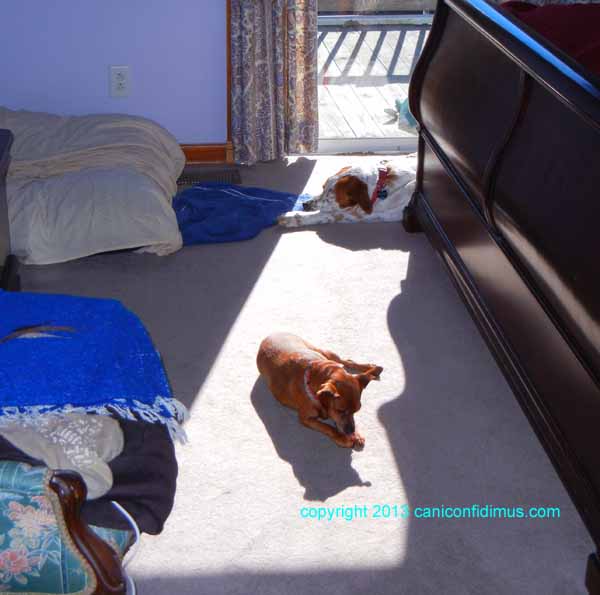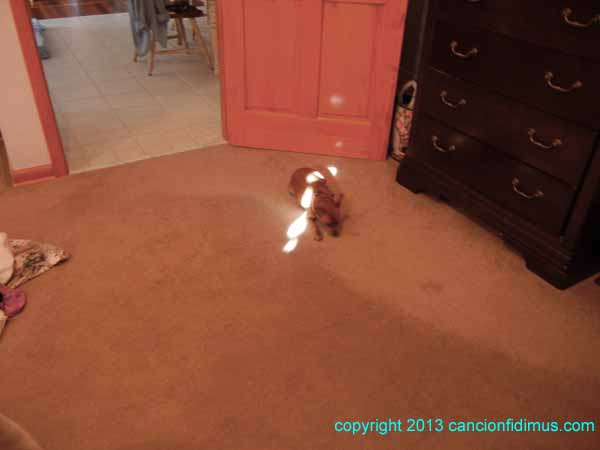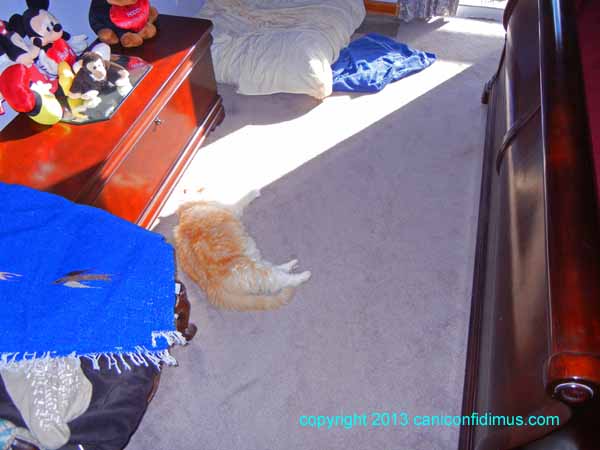Is there a better feeling than lying in the sun on a clear, cold, windy day? No, at least if you ask the dogs.

We wait until the sun is high enough to give some warmth before we open the curtains, so sometimes there’s very little sunlight when Lucy comes into our bedroom.

There’s a little sliver from the window. A little sun is better than none.
Zoe likes to lie in the sun, but sometimes he mistakes the location of his head for the location of his entire body.

But perhaps I do him a disservice; perhaps he simply wants to adjust his solar gain and thermal emission to maintain a constant, comfortable internal temperature. Yes, that must be it.
It’s no accident that the rear of our house faces south. When I was laying out the foundation lines for the house, I wanted the rear of the house to face as close to due south as I could manage, because I planned to have lots of windows in the south-facing side. One day I put a stake vertically in the ground, calculated the exact time of local solar noon, and waited. When it was solar noon, I made a line along the shadow of the stake. I used that line to define the direction that the house’s rear would face.
I could have simply used a compass, or waited until my watch said it was noon, but I wanted to be as accurate as possible, and both of those methods have problems. The compass would have shown me magnetic north, which, where we live, it is about four degrees away from true north. And, since each time zone is 15 degrees wide in longitude, the sun’s position at civil noon varies depending on where you are in the time zone. We are close to the western border of the Eastern Time Zone, so there would have been several degrees error from that.
Using a compass would have worked pretty well, all things considered, but since I knew the longitude of my house from a GPS receiver, I could calculate how far solar time is away from civil time, and, theoretically, get closer to true north.
Unfortunately, the sun’s azimuth (the compass direction from which the sunlight is coming) at noon at a given location varies through the year, so unless you put the stake in the ground on exactly the right date, your stake’s shadow will not point in a true north-south direction. Depending on the date, the sun’s azimuth can be a few degrees away from true south (in the northern hemisphere) at solar noon. However, a true north-south line would be the best orientation. Since the sun’s azimuth varies on both sides of the north-south line, that line would be closest on average to the sun’s azimuth.
My line was only a few degrees at most from a true north-south line, close enough that it makes very little difference in how much sun we get on a cold winter day. I could and maybe should have calculated the optimum roof overhang to provide shade in the summer and minimum interference with solar gain in the winter, but what we have is just about right.
We have six-foot sliding glass doors in the bedrooms and an eight-foot sliding glass door in the living room. We keep one side of the door in our bedroom covered with an insulation panel, so we only get half the possible solar gain in the bedroom, but that’s plenty on a sunny day. Even on sunny days when the outside temperature is below freezing, the bedroom temperature will exceed 70 degrees without running the heat. The living room will do the same.
I didn’t really maximize the house design for passive solar heating. There is no provision for increased thermal mass, so the temperature goes up quickly and then tends to go down fairly quickly when the sun dips below the pines in the back. But that’s what wood-burning stoves are for. Burning wood is just another way to get solar energy, although not as cleanly as absorbing it directly.
If I had it to do over again, I would probably change the house plan and construction a little. But I’m happy with what we have. The dogs, too.
![]() You can see the plume from the Euharlee power plant on the horizon. I don’t remember the temperature that day, but on a cold winter night there will typically be a fairly large electric power demand, so the plants will work hard.
You can see the plume from the Euharlee power plant on the horizon. I don’t remember the temperature that day, but on a cold winter night there will typically be a fairly large electric power demand, so the plants will work hard.![]() This is actually a vertical panorama. I couldn’t quite get everything I wanted, so I (actually, Photoshop Elements) stitched two shots together.
This is actually a vertical panorama. I couldn’t quite get everything I wanted, so I (actually, Photoshop Elements) stitched two shots together.![]() Since the sun is rising earlier these days, I don’t get out on the deck often enough to catch the sun right at the horizon. I usually see a good sunrise when I’m walking the dogs around the house first thing in the morning. The sunrise changes so quickly that I usually can’t get back inside, grab the camera and get out on the deck in time to get the most dramatic shot. That’s why the sun is so high in the sky in these pictures.
Since the sun is rising earlier these days, I don’t get out on the deck often enough to catch the sun right at the horizon. I usually see a good sunrise when I’m walking the dogs around the house first thing in the morning. The sunrise changes so quickly that I usually can’t get back inside, grab the camera and get out on the deck in time to get the most dramatic shot. That’s why the sun is so high in the sky in these pictures.